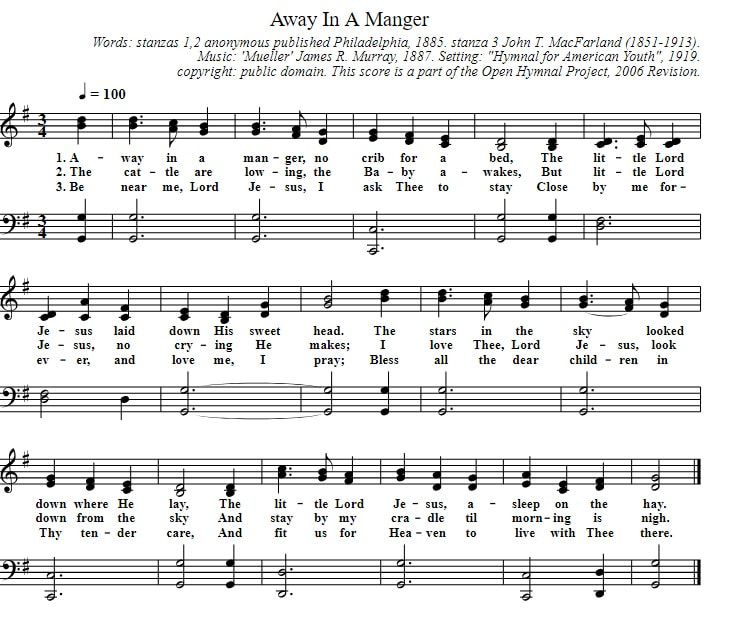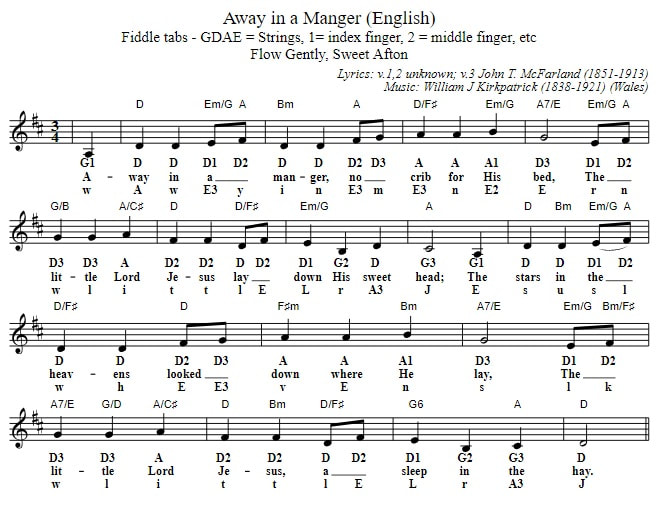Away In A Manger Tin Whistle Notes
The easy flute notes showing the finger positions in included. The piano keyboard or Melodica letter notes for beginners are included. Piano sheet music in the keys of C and G Major with chords . A Christmas Carol that's a favorite for children to sing and play. Away in a Manger violin sheet music for beginners is now added which shows which fingers to use on each string while playing each note. There's only one note that's different when playing the whole song through. It's in the 5th verse second line where the syllables don't quiet match but you'd get away with playing the same notes all the way through. This happens in almost every song as it's nearly impossible to write a song with the same amount of syllables in every word in every line. Also suitable for the recorder.Away in a Manger ukulele tab plus the fingerstyle guitar tab now included.
The hymn 'Away In A Manger' holds a significant place in the hearts of Christians worldwide, as it encapsulates the essence of the Nativity story and the birth of Jesus Christ. With its simple yet poignant lyrics and haunting melody, this beloved hymn has stood the test of time, remaining a cherished part of many Christmas traditions. Its origins can be traced back to the late 19th century, and since then, it has undergone numerous adaptations, translations, and interpretations, solidifying its place as a timeless classic.
The exact origins of 'Away In A Manger' are somewhat obscure, with conflicting claims about its authorship and composition. One popular theory credits American clergyman John Thomas McFarland as the composer, while others argue that the tune was brought to the United States from Germany and adapted by composer William J. Kirkpatrick. Yet, another theory suggests that the hymn was originally a poem written by Martin Luther for his children. The lack of concrete evidence only adds to the hymn's mystique, with its origins shrouded in a sense of mystery and wonder.
Despite the uncertainty surrounding its origins, one thing remains clear - 'Away In A Manger' has become an integral part of the Christmas tradition. Its gentle and soothing melody, coupled with its heartfelt lyrics, evokes a sense of peace and serenity, making it a popular choice for Christmas carols and church services. The first two verses of the hymn are believed to have been written by an anonymous author, while the third verse, 'Be near me, Lord Jesus,' is attributed to German-American Lutheran pastor and educator Charles H. Gabriel. This verse is often omitted in modern renditions, but its inclusion adds a layer of depth and emotion to the hymn, reminding us of the true reason for the season - the birth of Jesus Christ.
The lyrics of 'Away In A Manger' paint a vivid picture of the Nativity scene, with its famous opening lines, 'Away in a manger, no crib for a bed, the little Lord Jesus laid down his sweet head.' The humble and modest setting of the manger, with the newborn Jesus surrounded by animals, reflects the Christian belief in the humility and simplicity of Christ's birth. It also serves as a reminder of the virtue of humility, a central theme in the teachings of Jesus.
Moreover, the hymn's lyrics also convey a sense of love and adoration for the newborn Christ, with lines such as 'the stars in the sky looked down where he lay' and 'the little Lord Jesus asleep on the hay.' These phrases not only add to the lyrical beauty of the hymn but also symbolize the wonder and awe surrounding the birth of Jesus. The hymn's chorus, 'the little Lord Jesus, asleep on the hay,' is repeated throughout, emphasizing the central message of the hymn - the birth of a child who would go on to change the world.
In addition to its lyrical significance, 'Away In A Manger' also holds a special place in the history of Christmas carols. The hymn's popularity grew significantly in the late 19th and early 20th centuries when it was included in various hymnals and songbooks, making it accessible to a wider audience. Its inclusion in the popular songbook 'Little Children's Book for Schools and Families' in 1885 is believed to have played a significant role in its widespread popularity. The hymn's inclusion in the 1892 publication of 'The Evangelical Hymnal' further cemented its place in the Christmas canon, and it has since been translated into multiple languages, including Spanish, French, and German.
Despite its widespread popularity and numerous adaptations, 'Away In A Manger' has remained true to its original form, with its timeless lyrics and haunting melody standing the test of time. Its inclusion in Christmas celebrations and church services around the world is a testament to its enduring appeal and the universality of its message. It serves as a reminder of the true meaning of Christmas, a time to celebrate the birth of Jesus Christ and the love and hope that he represents.
In conclusion, the hymn 'Away In A Manger' is more than just a Christmas carol. It is a powerful and poignant reminder of the humble beginnings of Jesus Christ and the impact of his birth on the world. Its enduring popularity and timeless message make it a treasured part of the Christmas tradition, bringing joy and peace to millions of people around the world. As we continue to sing its lyrics and embrace its melody, we are reminded of the true reason for the season and the enduring power of the Nativity story.
The exact origins of 'Away In A Manger' are somewhat obscure, with conflicting claims about its authorship and composition. One popular theory credits American clergyman John Thomas McFarland as the composer, while others argue that the tune was brought to the United States from Germany and adapted by composer William J. Kirkpatrick. Yet, another theory suggests that the hymn was originally a poem written by Martin Luther for his children. The lack of concrete evidence only adds to the hymn's mystique, with its origins shrouded in a sense of mystery and wonder.
Despite the uncertainty surrounding its origins, one thing remains clear - 'Away In A Manger' has become an integral part of the Christmas tradition. Its gentle and soothing melody, coupled with its heartfelt lyrics, evokes a sense of peace and serenity, making it a popular choice for Christmas carols and church services. The first two verses of the hymn are believed to have been written by an anonymous author, while the third verse, 'Be near me, Lord Jesus,' is attributed to German-American Lutheran pastor and educator Charles H. Gabriel. This verse is often omitted in modern renditions, but its inclusion adds a layer of depth and emotion to the hymn, reminding us of the true reason for the season - the birth of Jesus Christ.
The lyrics of 'Away In A Manger' paint a vivid picture of the Nativity scene, with its famous opening lines, 'Away in a manger, no crib for a bed, the little Lord Jesus laid down his sweet head.' The humble and modest setting of the manger, with the newborn Jesus surrounded by animals, reflects the Christian belief in the humility and simplicity of Christ's birth. It also serves as a reminder of the virtue of humility, a central theme in the teachings of Jesus.
Moreover, the hymn's lyrics also convey a sense of love and adoration for the newborn Christ, with lines such as 'the stars in the sky looked down where he lay' and 'the little Lord Jesus asleep on the hay.' These phrases not only add to the lyrical beauty of the hymn but also symbolize the wonder and awe surrounding the birth of Jesus. The hymn's chorus, 'the little Lord Jesus, asleep on the hay,' is repeated throughout, emphasizing the central message of the hymn - the birth of a child who would go on to change the world.
In addition to its lyrical significance, 'Away In A Manger' also holds a special place in the history of Christmas carols. The hymn's popularity grew significantly in the late 19th and early 20th centuries when it was included in various hymnals and songbooks, making it accessible to a wider audience. Its inclusion in the popular songbook 'Little Children's Book for Schools and Families' in 1885 is believed to have played a significant role in its widespread popularity. The hymn's inclusion in the 1892 publication of 'The Evangelical Hymnal' further cemented its place in the Christmas canon, and it has since been translated into multiple languages, including Spanish, French, and German.
Despite its widespread popularity and numerous adaptations, 'Away In A Manger' has remained true to its original form, with its timeless lyrics and haunting melody standing the test of time. Its inclusion in Christmas celebrations and church services around the world is a testament to its enduring appeal and the universality of its message. It serves as a reminder of the true meaning of Christmas, a time to celebrate the birth of Jesus Christ and the love and hope that he represents.
In conclusion, the hymn 'Away In A Manger' is more than just a Christmas carol. It is a powerful and poignant reminder of the humble beginnings of Jesus Christ and the impact of his birth on the world. Its enduring popularity and timeless message make it a treasured part of the Christmas tradition, bringing joy and peace to millions of people around the world. As we continue to sing its lyrics and embrace its melody, we are reminded of the true reason for the season and the enduring power of the Nativity story.
How To Play Away In A Manger On Tin Whistle
Piano Keyboard / Melodica Letter Notes For Beginners Playing Away In A Manger
Below is another version of Away In A Manger piano sheet music in a higher key of C Major plus a version in the key of G Major.
Below is the list of sheet music and tin whistle songs that are in my ebooks. This is the largest collection of tin whistle songs ever put together.[over 800 songs ] Including folk, pop and trad tunes plus German And French songs along with Christmas Carols.
All of the sheet music tabs have been made as easy to play as was possible.
The price of the ebooks is €7.50
All of the sheet music tabs have been made as easy to play as was possible.
The price of the ebooks is €7.50
Away in a Manger violin sheet music for beginners










